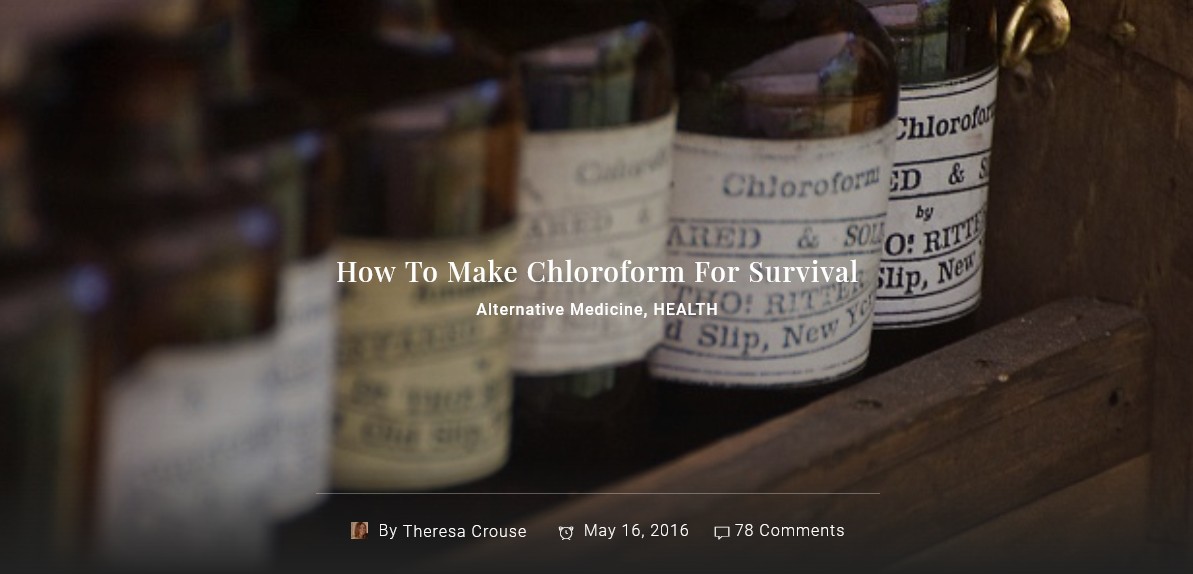👉 How To Knowledge from the Field of Master Mind Survival (MMSUR) 👌
Shared from the research of: Joseph Mercado🙇
Article Author: Theresa Krouse 👩
Content Contributor: Survivopedia 🌏
Blog Post #1164 📌
Re: How To Make Chloroform 🍶
Date and Time: Monday, April 5, 2021 at 10:44 a.m. ⌚
Dear Survivalist,
You’ve likely watched many movies where chloroform is used to knock people out in order to kidnap them or disable them for some other reason.
It’s definitely good for that, but subversive maneuvers aren’t what it was originally made for.
Originally it was used as an anesthetic to knock people out for surgery.
It sounds like a handy thing to have in your supplies, right? The problem is that you can’t just walk into your local superstore and pick up a gallon of it from the shelf beside the milk.
You can, however, make your own.
Chloroform, whether pharmaceutical grade or homemade, is lethal in the wrong hands.
Don’t use it without training!
That being said, if you have a medically-trained person in your group, knowing how to make it can come in handy in a variety of ways.
You can use it to anesthetize people for surgical procedures or to operate on animals for procedures such as castration.
It’s also used in pesticides, disinfectants, dry cleaning solutions, photography development, and refrigerators.
So, how can you make chloroform at home? Actually, it’s not that difficult – it involves two common household items – but it is a bit dangerous for both the patient and anybody within several feet of it.
There are actually a few different ways to make it, but keep in mind that this can very well kill the patient you are trying to save.
Yes, I’ve already said that, but it bears repeating. Now, on to it.
Gather Your Ingredients:
You know all those warnings you’ve heard about mixing your cleaning products? Well, there’s a good reason for them.
When combined, certain chemicals such as bleach create toxic fumes such as chloroform (yes, I said TOXIC), hydrochloric acid, chloroacetone, and other things you really don’t want to breathe.
Since we’re actually trying to make one of those chemicals, let’s proceed with it.
Household bleach is your first ingredient. It needs to be at least 6 percent without any added ingredients.
If you use a higher concentration, you’re going to need more ice, which I’ll explain in a second.
The second ingredient is used by most women for cosmetic purposes and by many men (and women) to shine their rides with an awesome paint job.
Acetone, also known as fingernail polish remover or paint reducer.
Be careful to read labels though, because these products aren’t always pure acetone or even acetone at all.
You can buy acetone in the cosmetics section of your local superstore and you can also buy it at most paint stores where it will probably be labeled simply as acetone.
The final ingredient is one that’s really tricky. You’ll actually have to walk all your way to the freezer for it. It’s ice!
So to recap, the ingredients you will need are: household bleach, acetone, ice.
Gather Your Equipment:
- You’re going to need a large glass container. HDPE buckets will work because the reagents won’t attack it, but you won’t be able to see the chloroform forming as well.
- A separation funnel will be needed to separate the chloroform from the other ingredients. You can do it with other tools such as an eyedropper, but that’s a long row to hoe. You can get a separation funnel online for about $25.
- A gas mask is highly recommended because of the risk of inhaling the fumes. You should make the chloroform in a well-ventilated area even if you’re using the mask. The vapors alone can make you nauseated, give you a headache or even make you pass out.
- A stir stick will be necessary. Glass is, of course, the best tool for this job.
Make the Chloroform:
I feel the need to warn you again to be careful. This isn’t something you should use as a family science experiment. If you’re ready to move ahead, gather your ingredients and equipment together in a well-ventilated area.
It’s best to start with the bleach and acetone chilled even if you’re using ice because the reaction will cause the mixture to heat up by at least 85 degrees. The higher concentrate bleach you use, the hotter it gets. The ratio for making chloroform needs to be 1 part acetone to 50 parts bleach. That’s 1 teaspoon of acetone per cup of bleach.
Place the bleach in the container, then add several ice cubes.
Add the acetone and stir the mixture, or swirl it around if you’re using a vessel that allows you to do that without sloshing it out.
If you’re using a high concentrate of bleach, i.e. 12 percent, add more ice.
Leave the mixture alone for 30 minutes to an hour so that the chemical reaction can develop and the mixture can cool.
First, you’ll notice a white cloud of vapor coming from the solution and the solution itself will become cloudy.
You don’t want to breathe this! You’ll also be able to see a white residue, powder, or bubble forming on the bottom.
That’s the chloroform.
After the hour is up and the mixture is cool, gently pour most of the liquid off the top.
Be careful to leave the chloroform on the bottom.
Once you’ve gotten most of the liquid out, transfer the rest to your separation funnel.
Let it settle, then drain the chloroform out, leaving behind the water.
You’ll yield around 50-70 percent of your starting material volume in chloroform.
At this point, the chloroform is created but if you’re going to use it on people, or animals for that matter, it needs to be distilled in order to purify it.
Obviously, you’ll need a distiller for that.
Other Ingredients to Combine:
If you have a copper still (and who doesn’t?) laying around, this is the way to distill your chloroform into liquid.
You can use the ingredients listed above or you can use 4 parts of bleaching powder (32.5-34.5 percent), 3 parts 96% alcohol, and 13 parts water.
The actual distillation process for this is lengthy and requires several different steps.
It’s not particularly viable for the average person, but I wanted to make you aware of it.
Because chloroform, either pharmaceutical grade or homemade, is thought to be carcinogenic, is dangerous to use and make, and doesn’t have much shelf life, it may not be your best option for use in a survival situation.
Topical analgesics or oral pain meds may be the better option.
Shoot, even doing it as they did in the Wild West is a better option – take a shot of liquor until you feel no pain.
Seriously, chloroform is nothing to fool around with.
If you want to make it at home, now you know how but do so with care.
Your life, or the life of the person you administer it to, will depend upon it.
Being skilled is the only asset that you can really count on if things are going South.
Be prepared and train your medical skills to face disaster!
Written by Theresa Crouse:
Theresa Crouse is a full-time writer currently living in central Florida. She was born and raised in the hills of West Virginia, where she learned to farm, hunt, fish, and live off the land from an early age. She prefers to live off the grid as much as possible and does her best to follow the “leave nothing behind but footprints” philosophy. For fun, she enjoys shooting, kayaking, tinkering on her car and motorcycle, and just about anything else that involves water, going fast, or the outdoors.
Content Source: Survivopedia.com

 Email Us a Message
Email Us a Message 

Please send us a personal message below and we will serve you momentarily.
We appreciate you visiting the MMU Global Research Directory
For more blog posts, videos, articles, and to generate more knowledge, please feel free and…






 Fly Over to the MMU Facebook Page with Hoot
Fly Over to the MMU Facebook Page with Hoot
 Visit the MMU Facebook Group Today
Visit the MMU Facebook Group Today 